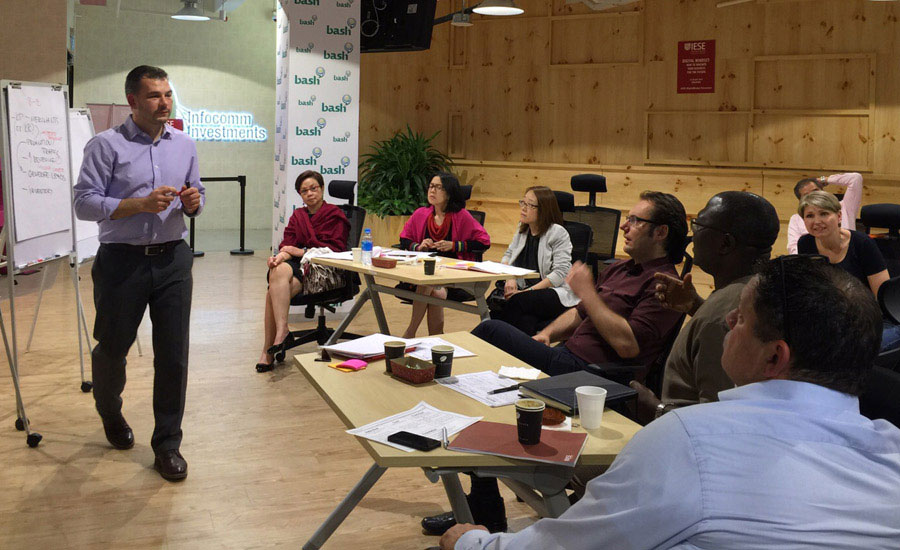
A select group of 15 participants from diverse sectors and seven countries gathered in Singapore for the Focused Program “Digital Mindset: How to Innovate Your Business for the Future.” The first of its kind in Asia, some of the companies represented were: Accenture, Honeywell, HP, Intellipath Games and Medtronic.
The ideation center ACE (Action Community for Entrepreneurship) and the accelerator space BASH (Build Amazing Startups Here), provided the perfect backdrop for the two-day course. The program brought together digital transformation and traditional innovation, presenting participants with the necessary analytical models and tools to take advantage of the vast field of new opportunities that digital transformation is bringing to the business environment. Led by IESE Professors Evgeny Káganer and Paddy Miller, participants grappled with the why, what and how of digital transformation, focusing on its basic building blocks to establish a long-term vision.
Getting to Grips With the Why
Prof. Miller opened by highlighting the key to understanding digitalization. It’s about asking the right questions and changing focus. “We’ve gone beyond the initial generic questions. It’s time to start asking ourselves: what are the big issues? It’s about reframing the problems and our vision instead of reframing solutions,” said Prof. Miller.
“The challenge is that the pace of change is quite significant. There are changes coming from the outside and from all sides, from customers and new competitors. Most executives are forced to respond before they can even make sense of what’s going on. There are a lot of issues to address, regardless of industry,” said Prof. Káganer. “Companies need to start thinking about how to rethink and remake the ways in which they add value to their customers. I’ve seen a lot of young people that know a lot about digital tools but can’t connect the dots and don’t understand the business ramifications. You don’t need to be young to get it. You need to be willing,” he said.
Identifying the What and How
On day one, participants focused on thinking about the what of digitalization: how their business was going to look like in a world where everybody and everything is interconnected. Next on the cards was converting their vision into a portfolio of specific ideas for how they could start taking advantage of digital within the context of their business. This entailed rethinking the value proposition of their companies, drawing up ideas to compete through digital business models, taking into account the scope and timing of impact.
Guest speaker, Laurence Smith, managing director HR, group head of learning & talent development of DBS, one of the largest banks in Singapore with which IESE is currently doing some research, later joined the group to tell his story about the digitalization process at the bank.
Day two tackled the how of digitalization. Participants were asked to come up with a 60-day action plan, looking at the pros and cons of their business models. Most participants agreed that this was the most challenging part. Establishing a new mindset throughout the organization, starting with the top, was easier said than done.
For participant Ilona Simpson, group IT head of Aston Martin Lagonda in London, “digital is a phenomenon that over the years has become more complex, and the veil of mystery around has become opaque. The course was a very intense experience but helped to demystify it,” she said.
“Digital came to the fore at IESE five years ago. Back then I had to convince executives that this was something worth paying attention to. Today, everyone across all sectors, whether media or luxury goods, wants to talk about it. Yet while there is tremendous awareness in the C-Suite, there is still a lot of confusion as to what it actually is, and how to make sense of it. In Asia, digital is different than in other parts of the world. And there are a lot of exciting things happening here which we can learn from,” concluded Prof. Káganer.